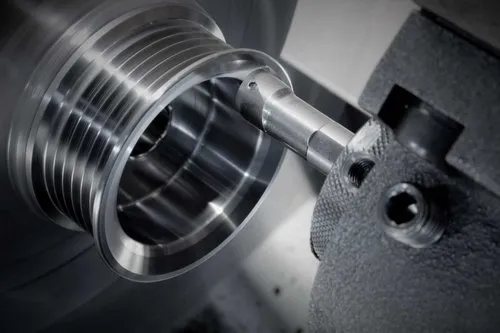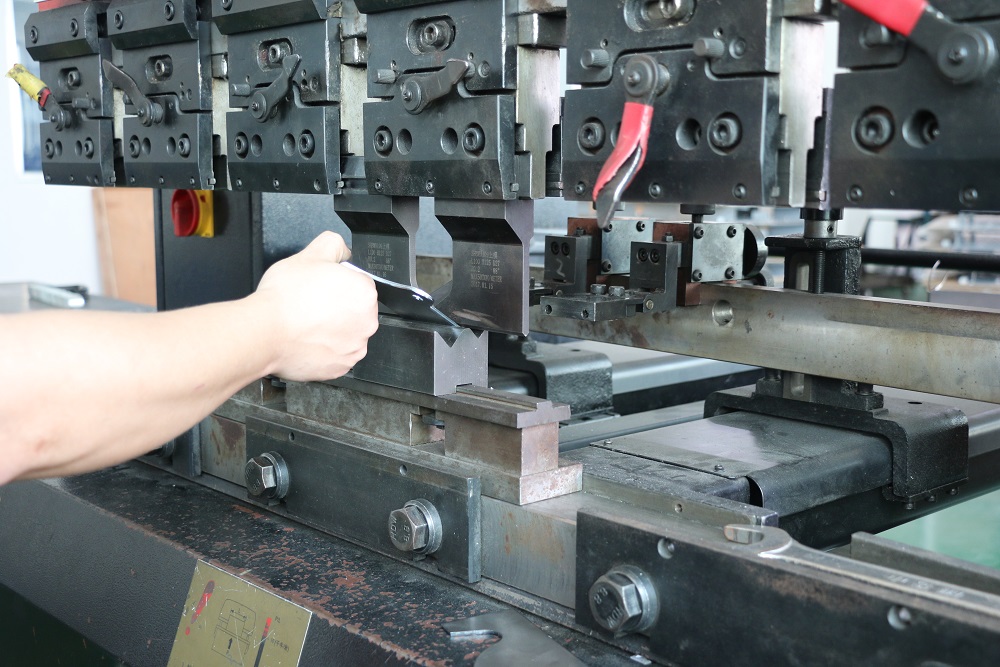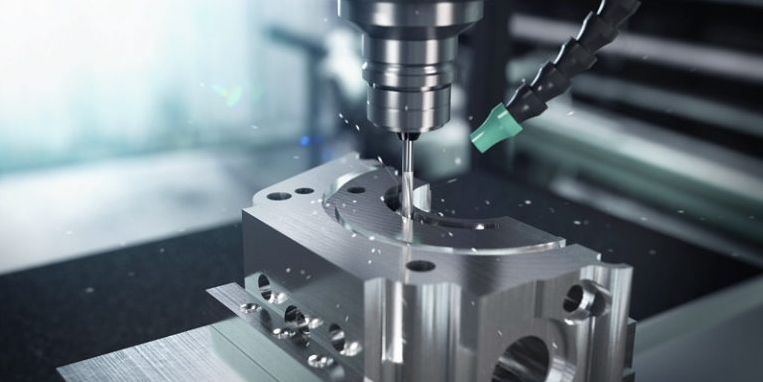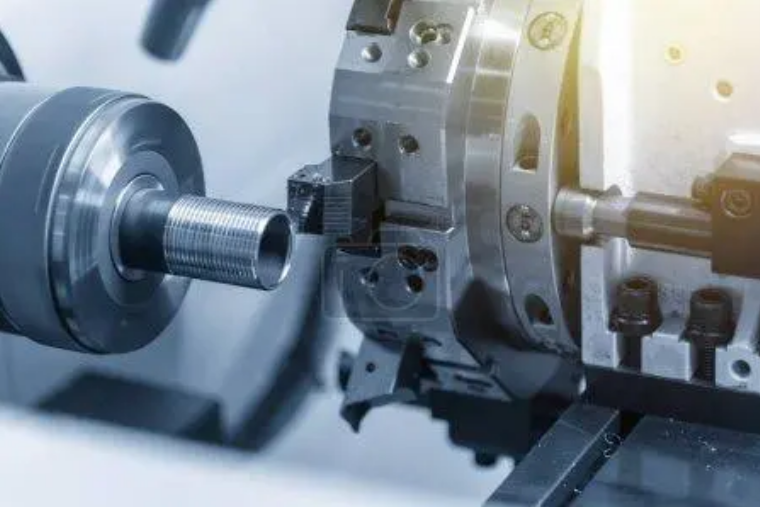CNC machining works with stationary workpieces and moving tools for various part sizes, while Swiss machining uses a sliding headstock for high-precision production of small, intricate parts.
Machine Configuration and Operation
CNC machining and Swiss machining differ largely in how the workpiece and tools are positioned and manipulated. By considering their setup and operation, here is how these two processes differ.
CNC
CNC machining involves fixed workpieces and moving tools. Consequently, it is highly versatile and can be used to create workpieces of varying shapes and sizes. Typically, this category of machining tools has multiple axes, such as 3-axis and 4-axis, though some machines go up to 5-axis. As a result, the systems can be used for machining complex parts.
The tool moves in reference to the unmoved workpiece. The tool’s movement is coordinated by a computer program that reads design specifications and makes continuous adjustments to manufacture the final product. Notably, CNC machining can be used for creating finishes, as well as thread.
Swiss
In contrast, with the Swiss category, the workpiece moves, while the tool is kept stationary. The movement of the workpiece is made possible by a sliding headstock, allowing the object to move axially. As a result, parts can be created with maximum effortfulness and precision, which is especially useful for processing long and slender components .
Swiss machines are characterized by a guide bushing, which the workpiece is supported by. The guide bushing is an essential part of the configuration as it decreases the degree of vibration and deflection, and allows the workflow to create the most precise part. Overall, the Swiss category is used largely for smaller parts, such as those found in medical devices, watches, and outerwear.
Key Differences in Machine Configuration and Operation
Here’s a comparison between CNC machining and Swiss machining across several factors:
| Factor | CNC Machining | Swiss Machining |
|---|---|---|
| Workpiece Movement | Stationary workpiece with moving tools | Workpiece moves axially with a fixed tool |
| Tool Changes | Capable of quick tool changes | Limited tool changes, focuses on continuous production |
| Axes Configuration | Generally features 3-axis, 4-axis, or 5-axis machines | Often operates with sliding headstocks and guide bushings |
| Application | Versatile, suitable for various part sizes and complexities | Ideal for small, precise parts in high-volume production |
The key distinction is that CNC machines use a traditional approach where tools move around a stationary workpiece, while Swiss machines allow the workpiece to slide axially, enabling high-precision machining with a focus on smaller parts.
Part Complexity and Size
CNC machining and Swiss machining both have highly effective processes for production. However, they have their unique value propositions and strengths when it comes to part complexity and size. As such, these points are examined closely in this essay.
Taking the Process Apart
The processes can be viewed in terms of what applications they are commonly used for, and what constraints and capabilities they exhibit. Each operation was mentioned in relation to the typical applications and the constraints surrounding them.
CNC Machining
CNC machining is renowned for its flexibility and can be used for highly complex parts of almost any size. Currently, large components are readily produced using CNC equipment, with some machines in the manufacturing industry capable of handling parts that are over 10 feet in length . The relevant industries that take advantage of such processes include aerospace, automotive, and heavy machinery manufacturing.
The multi-axis nature allows for intricate cuts and odd geometries. Available configurations include 3-axis, 4-axis, and 5-axis setups that can rotate and manipulate parts. The process can be set up to perform milling and turning and almost any other operation required with relative ease . Because of this, the process can handle even multi-featured, shape-heavy components.
Swiss Machining
Swiss machining is a smaller-scale solution and is equipped for even smaller parts within quite severe size constraints . It was mentioned in the previous paper that Swiss machining is generally used for parts ranging from fractions of an inch long, to several inches . The process is widely used in the medical industry to produce highly advanced instruments that are detailed down to microns. The electronics industry also benefits greatly from using it, as does the highly precise watch-making industry.
The sulled headstock and the guide bushing system combine high precision and ease of manufacturing by quite severely limiting the part size. However, the guide bushing does exactly what it was designed to do and immediately provide support for the workpiece. As the cutting starts, the workpiece does not vibrate or deflect due to the amount of steel surrounding it. This cuts down on cutting zones that could be interrupted and disrupt the cutting, resulting in high precision and extremely low cutting forces . A variety of complex threads, shapes, slots, and holes such as cross-holes can be easily machined at very high speeds as a result. The slide headstock also reduces the rigidity of the setup, which decreases tool deflection . Ultimately, a highly complex part can be produced with far tighter tolerances using a Swiss machine.
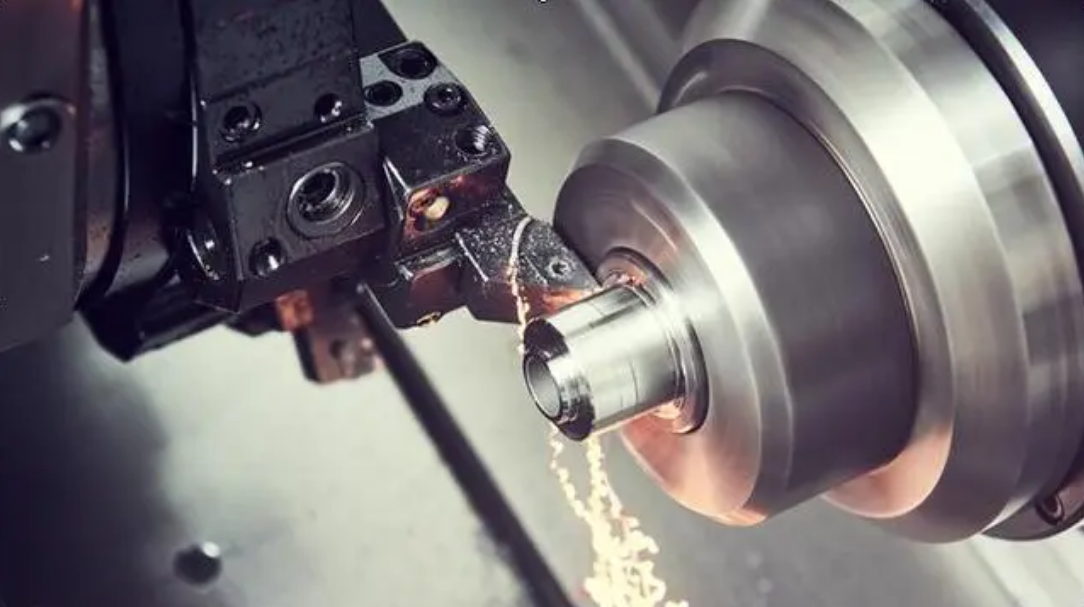
Tolerance and Precision
Both tolerance and precision play vital roles in manufacturing. However, they are primarily influenced by the approaches used by CNC and Swiss machining in ensuring accuracy. This piece highlights the specific tolerance capabilities of each technique and explains the reasons behind them.
CNC Machining
CNC machining is best known for its precision. As a result, it delivers incredible tolerances that often range from a few thousandths of an inch to micrometers. Typically, precision machining requires high levels of setup accuracy, provided by factors such as machine frame rigidity, tool calibration, and software control. Also, the multi-axis configuration allows CNC machines to create parts with many features, with each feature maintained at precise tolerances. Additionally, the computer controls used in the processing machines are programmed by the operator to follow exact specifications such as a work design , guaranteeing the necessary level of parts machining. This has made CNC machining suitable for the production of aerospace and automotive parts for which safety and performance depend on a very narrow spectrum of tolerance.
Swiss Machining
Swiss machining is the least-tolerant of the two options, with tolerances as tight as 0.0001 inches due to the unique sliding headstock design. The guide bushing of the Swiss machine is tightly clamped to the workpiece and keeps it from oscillating . In turn, this design virtually eliminates deflection and vibration during machining, allowing for more accurate cuts . Specifically, Swiss machining delivers ultra-high tolerance in the production of medical aids workpieces in the field of micro-manufacturing and for watch gears.
Due to the unique features of CNC machining and Swiss machining and the specific methods each use to ensure high precision, the following three simple steps remain the same:
-
Calibration: Both machines must be recalibrated frequently to ensure continued accuracy.
-
Material Handling: If the workpiece vibrates during the cutting process due to poor fastening, the part can loosen and move slightly, reducing precision.
-
Quality Control: To Service, all parts need substantial and regular inspection of control processes to ensure precise conditions for all cutting and forming work.
In conclusion, CNC machining is generally more tolerant due to its versatile application, allowing a wide range of parts and sizes to be processed and approach high precision from a few thousandths of an inch to micrometers. In contrast, Swiss machining is very precise and is used to create ultra-tolerant parts on a very small scale. Therefore, the selection between CNC machining and Swiss machining depends on the required precision level. If you need parts with the tightest tolerances, consider using Swiss machining.
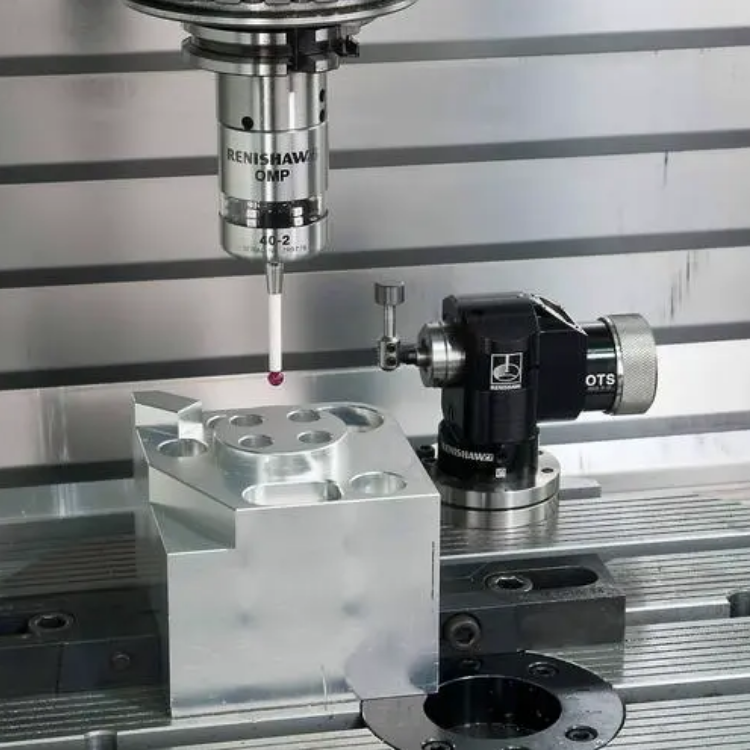
Production Volume and Efficiency
When choosing between CNC and Swiss machining, production volume and efficiency are among the most important considerations. Both methods have their unique features that determine the speed and quality of parts production. In addition, production volume is one of the factor that largely defines how quickly and efficiently parts can be produced using these methods.
CNC Machining
CNC machining is versatile and can be used for creating parts of both small and large production volume. Both rapid prototyping and full-scale manufacturing can be implemented using CNC machines. This method is convenient for the aerospace, automotive, and consumer electronics industry because of the possibly rapidly changing needs to produce different characteristics and a variety of parts.
The efficiency of CNC machining primarily depends on the characteristics of machinery and tools used. For example, if a CNC machine has several axes, it can easily switch between different operations and consequently reduce the time for switching or tool changing. Apart from that, if the machine requires complicated setup, slow and complicated tool changing, the efficiency of CNC machining can be lower. It is also essential to note that for large production volumes, CNC machining is more efficient because it can be easily automated. Setting-up CNC machines to perform several operations at once is an efficient way of reducing cost and time of parts manufacturing, especially considering that the majority of parts are highly complex.
Swiss Machining
Swiss machining is used in the production of small and highly detailed parts. It is designed to be used for high volume production, which is common for the medical device and electronics industry. Swiss machining uses continuous operation and a sliding headstock that allows the part to be cut close to the guide bushing. The guide bushing also acts as a support for a long and narrow part.
One of the main advantages of Swiss machining in terms of efficiency-enhancing characteristics is the fact that the part can be continuously cut without removing from the machine. As a result, the machine hardly ever stops, contributing to a higher speed of part production. Apart from that, the bushing allows the part to be stable, which is an essential condition for maximum cutting speed. At last, Swiss machines have several positions for additional tools, which allows for cutting in several places and for completing different tasks within a single setup. The cutting is continuous, and no manual adjustments are made.
Choosing the best method in terms of production volume and efficiency depends on your current volume of part production and how the part’s size and requirements are likely to change. Swiss machining is more efficient for high-volume production, aim a maximum production speed of small, highly detailed parts. CNC machining is best used for larger parts of a wide range of sizes.

